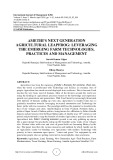
http://www.iaeme.com/IJM/index.asp 1 editor@iaeme.com
International Journal of Management (IJM)
Volume 9, Issue 2, March–April 2018, pp. 1–15, Article ID: IJM_09_02_001
Available online at
http://www.iaeme.com/ijm/issues.asp?JType=IJM&VType=9&IType=2
Journal Impact Factor (2016): 8.1920 (Calculated by GISI) www.jifactor.com
ISSN Print: 0976-6502 and ISSN Online: 0976-6510
© IAEME Publication
AMETHI’S NEXT GENERATION
AGRICULTURAL LEAPFROG: LEVERAGING
THE EMERGING FARM TECHNOLOGIES,
PRACTICES AND MANAGEMENT
Suresh Kumar Gigoo
Rajarshi Rananjay Sinh Institute of Management and Technology, Amethi,
Uttar Pradesh, India
Dileep Maurya
Rajarshi Rananjay Sinh Institute of Management and Technology, Amethi,
Uttar Pradesh, India
ABSTRACT:
Agriculture has been the mainstay of India’s Economy for centuries. Even now,
when the world is proliferated with Technology and Science in everyday lives of
people, Agriculture has stood out and displayed stoic resilience. This is because Food
touches the very basic need of humans. Most of the farmers around the world are
using the farming or agricultural practices based on the knowledge and experience
gained over generations and generations. With Food Security increasingly threatened
with millions of humans adding up every day, Agriculture in modern times has to
gradually transform towards leveraging increased automation and Technology for
faster yields with less resources. The paradigm shift has the potential to transform the
face of our villages and cities. Amethi Region in Uttar Pradesh, Northern India, a
political Super brand of Indian politics, being known for affiliation to Nehru-Gandhi
dynasty and previously ruled by Royal Maharajahs of Amethi since 10th century is well
poised and positioned to reap the benefits of modern Agricultural practices and be an
Agricultural hub. India’s stunning economic growth is not only gobbling up spaces
like a giant sponge but gradually eating up the beautiful scenic lands of our villages
also. Pristine vistas with rows and rows of green fields are becoming History by the
day. This paper describes the various measures and methods by which Amethi can be
an Agriculture leader by blending core Agriculture with modern Technology with
priority to leave maximum open spaces “ intact and green” for enjoyment by next
generation people who are getting restricted in claustrophobic cities and towns.
Keywords: Agriculture, Land, Farming, New Generation Agri –Tech Practices, Farm
Mechanization, Tower Farming, Drone Farming, Amethi Agriculture Steadfast 21.0





















